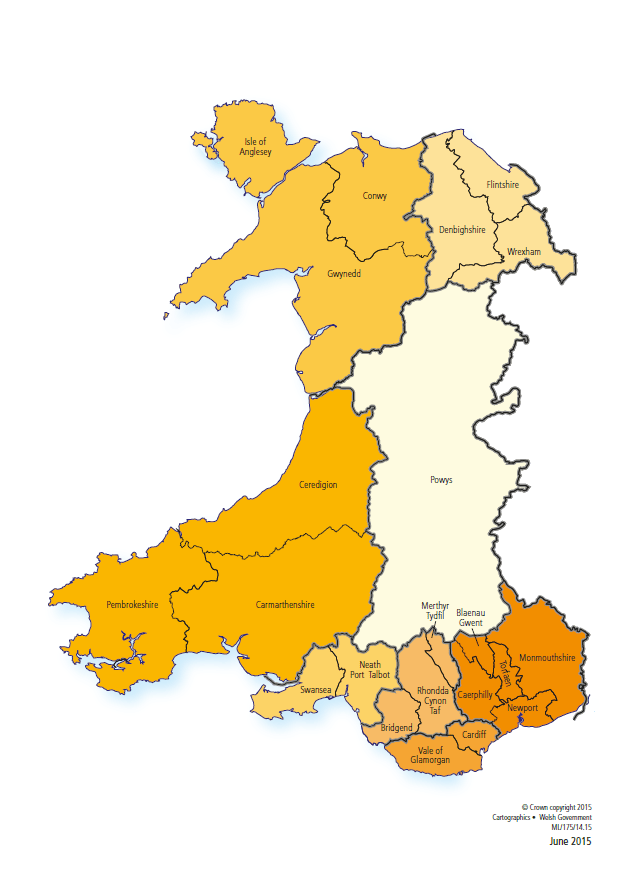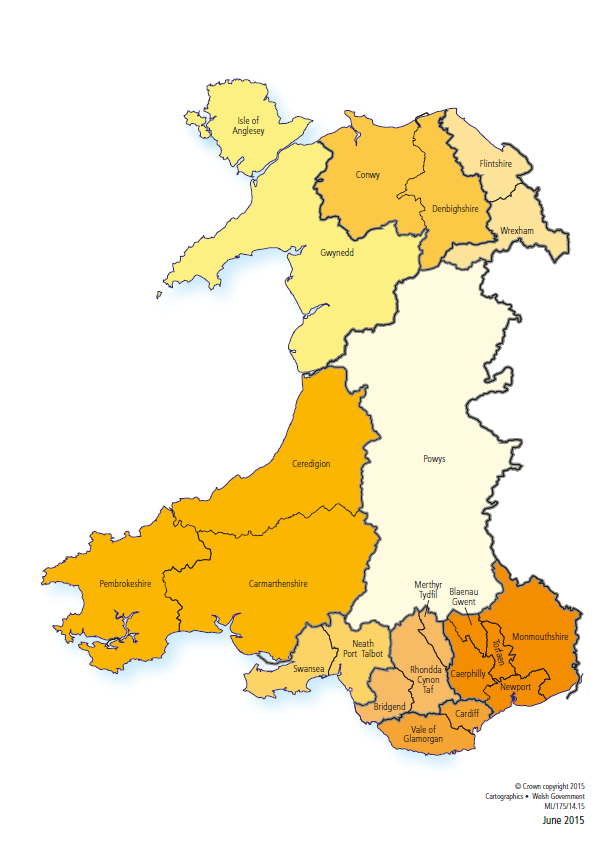Article by Rhys Iorweth, National Assembly for Wales Research Service
Tomorrow (2 July), Leighton Andrews, the Minister for Public Services, appears before the Assembly’s Communities, Equality and Local Government Committee for a general scrutiny session with Members. With the Minister having published the Welsh Government’s preferred map of new local government areas on 17 June, there will be no points for guessing what’s likely to be the main topic of discussion. Since it formally responded to the Williams Commission report in July 2014, the Welsh Government has consistently stated that its preferred configuration for local government in Wales was the 12-council model proposed in the Williams report. After giving “further consideration” to a “range of issues”, the Minister for Public Services has now proposed a configuration of either eight or nine local authorities (with the option of having either two or three councils in north Wales). 
 The Minister has emphasised that his proposals are meant to “drive down the cost of politics and administration”, but has provided little detail about the “range of issues” that made the Welsh Government re-think its original preference. During recent scrutiny work, the Communities, Equality and Local Government Committee has heard evidence suggesting that large scale authorities are often better suited to deliver certain services – such as strategic planning, education, transport and social services. However, there also seems to be acknowledgement that larger authorities could carry the risk of undermining local accountability and the relationship between councils and the communities they serve. As such, while there is general agreement that the current 22-council model is in need of reform, getting consensus on how that should be done is a much tougher task. Critics might claim that, before producing any map and deciding on the future number of local authorities, the Welsh Government should have first reassessed what type of services local government should be delivering in a devolved Wales. Put another way, that form should follow function. Since the current local government structure was created in 1996, there have been fundamental changes to the way Wales is governed. As such, local government representatives say that there is a need to redefine the relationship between central and local government, and to re-evaluate what local government’s role should be in the delivery of modern services. In June 2014, the Welsh Local Government Association (WLGA) published its In Defence of Localism document, in which it criticised the Welsh Government for “developing a more centralised and assertive approach” to public services. It then suggested that local government should be given more “freedom and flexibility to deliver services according to local circumstances”. The WLGA reiterated such calls at its annual conference on 18 July 2015, again posing the question “what is local government, and what do we want local government to do?” The Welsh Government’s potential response would be that it has sought to address these very concerns in its February 2015 White Paper: Reforming Local Government: Power to Local People. According to the Minister for Public Services, this White Paper “was very much about decentralisation” and “granting the general power of competence to local authorities and giving them the powers and responsibilities that they deserve and that they have requested”. However, some would counter that only after redefining those powers and responsibilities can you come up with appropriate delivery structures. In other words, by producing a map before that process has been fully carried out, the Welsh Government could be said to be putting the cart before the horse. This debate intensifies when considering that the current Welsh Government approach only goes as far as to merge the current local authority units along existing boundaries. Indeed, the Communities, Equality and Local Government Committee has itself suggested that by looking more fundamentally at functions and boundaries, a more enduring and robust local government configuration for the future might be found. Another interesting question is what happens next in the context of the Local Government (Wales) Bill, which is currently progressing through the Assembly. This is the first of two local government bills intended to deliver the reform process. While the second Bill will contain the main merger proposals, and will only be published in draft form in the autumn, this first Bill is notable in the fact that:
The Minister has emphasised that his proposals are meant to “drive down the cost of politics and administration”, but has provided little detail about the “range of issues” that made the Welsh Government re-think its original preference. During recent scrutiny work, the Communities, Equality and Local Government Committee has heard evidence suggesting that large scale authorities are often better suited to deliver certain services – such as strategic planning, education, transport and social services. However, there also seems to be acknowledgement that larger authorities could carry the risk of undermining local accountability and the relationship between councils and the communities they serve. As such, while there is general agreement that the current 22-council model is in need of reform, getting consensus on how that should be done is a much tougher task. Critics might claim that, before producing any map and deciding on the future number of local authorities, the Welsh Government should have first reassessed what type of services local government should be delivering in a devolved Wales. Put another way, that form should follow function. Since the current local government structure was created in 1996, there have been fundamental changes to the way Wales is governed. As such, local government representatives say that there is a need to redefine the relationship between central and local government, and to re-evaluate what local government’s role should be in the delivery of modern services. In June 2014, the Welsh Local Government Association (WLGA) published its In Defence of Localism document, in which it criticised the Welsh Government for “developing a more centralised and assertive approach” to public services. It then suggested that local government should be given more “freedom and flexibility to deliver services according to local circumstances”. The WLGA reiterated such calls at its annual conference on 18 July 2015, again posing the question “what is local government, and what do we want local government to do?” The Welsh Government’s potential response would be that it has sought to address these very concerns in its February 2015 White Paper: Reforming Local Government: Power to Local People. According to the Minister for Public Services, this White Paper “was very much about decentralisation” and “granting the general power of competence to local authorities and giving them the powers and responsibilities that they deserve and that they have requested”. However, some would counter that only after redefining those powers and responsibilities can you come up with appropriate delivery structures. In other words, by producing a map before that process has been fully carried out, the Welsh Government could be said to be putting the cart before the horse. This debate intensifies when considering that the current Welsh Government approach only goes as far as to merge the current local authority units along existing boundaries. Indeed, the Communities, Equality and Local Government Committee has itself suggested that by looking more fundamentally at functions and boundaries, a more enduring and robust local government configuration for the future might be found. Another interesting question is what happens next in the context of the Local Government (Wales) Bill, which is currently progressing through the Assembly. This is the first of two local government bills intended to deliver the reform process. While the second Bill will contain the main merger proposals, and will only be published in draft form in the autumn, this first Bill is notable in the fact that:
- As currently drafted, it still allows local authorities who wish to merge voluntarily – and early – to submit applications to do so;
- It will enable the Minister to direct the Local Democracy and Boundary Commission for Wales to start electoral reviews of the new proposed areas published in the recent map – and the Minister can do this as soon as the first Bill come into force (expected to be late this autumn).
The Minister has stated that the published map “is not a final decision” and merely a “platform” on which his party will campaign in the run-up to the 2016 Assembly elections. However, the first Bill as currently drafted could give the Minister the power to direct the Boundary Commission to start reviewing the electoral arrangements of the new areas before the end of this year. Indeed, the latest indications are that the Minister intends to consult on such directions shortly. The above, of course, are not the only issues of interest. During passage of the Local Government (Wales) Bill, the Communities, Equality and Local Government Committee has often discussed the potential costs of the merger programme. Issues around council tax harmonisation and use of the Welsh language within the new authorities have also been prominent. So have the implications for current collaborative and regional working, as well as staffing considerations. The Committee’s meeting tomorrow will hopefully add some detail to what we already know about the Welsh Government’s proposals. Images from Welsh Government (www.gov.wales)






